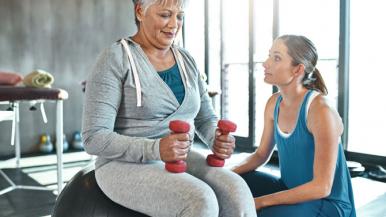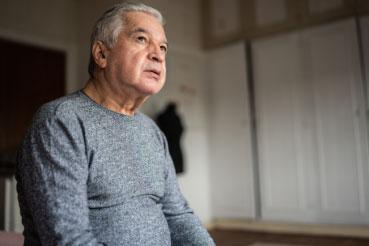Some disorders that affect the brain can make movement difficult. But staying active — despite the challenges — can actually play a key role in managing symptoms.
What follows is a close look at how exercise helps three common neurological conditions.
Alzheimer's disease
How exercise helps: Alzheimer's disease is an irreversible, progressive nervous system disease that targets the brain. It slowly destroys memory and thinking skills, and it is the most common cause of dementia in older adults.
Exercise may help lower the risk of Alzheimer's. But staying active can also help those who already have the disease.
For example, exercise may help slow its progression. One study found that fit people with early Alzheimer's had far less brain tissue shrinkage (this shrinkage is one of the hallmarks of the disease) than their less fit peers. Other research suggests physical activity may help delay or slow a decline in thinking skills and reduce stress in people with Alzheimer's.
Regular exercise also helps people with Alzheimer's continue to perform many everyday activities even as the disease progresses. It can help improve balance, prevent falls and counter depression, which often affects people in the middle stages of the disease.
What kinds of exercise are best: It's important for people with Alzheimer's to get a doctor's OK before exercising. Activities such as walking, balance and strength training, and stretching are just a few good options.
A physical therapist can help create a tailored exercise program. That’s especially important during more advanced stages, when safety concerns and physical and mental limitations posed by the disease often become more significant.
Multiple sclerosis
How exercise helps: Multiple sclerosis (MS) is a nervous system disease that targets the brain and spinal cord. It damages the myelin sheath, the material that surrounds and protects nerve cells. Because of this damage, messages between the brain and body slow down or become blocked.
Research shows regular exercise increases fitness, builds strength and stretches muscles, all of which help those with MS manage many symptoms, including the following, that can hinder everyday activities:
- Muscle spasms (spasticity)
- Balance problems
- Fatigue
- Bladder and bowel function
Staying active can also help improve thinking and ease the depression that can accompany the disease.
What kinds of exercise are best: There is no one-size-fits-all exercise program for people with MS. Which types of exercise someone should pursue — and how much they should do — depend on their abilities and limitations, since symptoms of MS can vary.
In general, good activities for people with MS include the following:
- Aerobic workouts using a rowing machine or stationary bike for added stability
- Pilates, yoga and tai chi, which can help improve balance, build strength and lift mood
- Water workouts — the water's buoyancy makes movement easier and helps the body stay cooler. (Overheating can trigger MS symptoms in some people.)
You can think of exercise as a medication without adverse effects.
Parkinson's disease
How exercise helps: Parkinson's disease is a chronic, progressive disorder that affects the body's ability to control movement. Common symptoms include the following:
- Tremors or shaking in the hands, arms, legs, jaw and face
- Stiffness in the arms, legs and torso
- Difficulties with balance, speech and coordination.
Exercise reduces many of these Parkinson's symptoms, so you can think of exercise as a Parkinson's medication without adverse effects.
Some of exercise's effect on Parkinson's likely has to do with its effect on the brain. Research shows vigorous exercise may increase substances in the brain called neurotrophic factors. These factors that promote healthy cells are reduced in people with Parkinson's.
Because of exercise's many benefits, Rush movement disorders specialists encourage their patients to start being physically active soon after their diagnosis — or to stay active if they already are. In fact, it's a treatment patients can start even before they need any medications for their symptoms.
Those who are active often find their overall health is greatly improved,.
What kinds of exercise are best: Just about any movement is good as long as it raises your heart rate and causes you to break a sweat.
People with Parkinson's can do all sorts of activities — from tango dancing to Karate. So pick something you love, and find a "partner in crime" to do it with. Just be reasonable, and don't overdo it.




